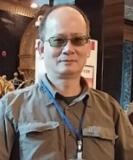Keynote Speaker----Prof. Dr. Chih-Huang Weng

Professor, Department of Civil Engineering, I-Shou University, Kaohsiung, Taiwan
Prof. Chih-Huang Weng is a faculty member of the Department of Civil and Ecological Engineering at I-Shou University, Taiwan. He received his MS and Ph.D. degrees in Environmental Engineering from The University of Delaware (USA) in 1990 and 1994, respectively. He has published over 80 papers in SCI journals and 35 of them H-index with 3695 citations in Mendely database. He serves as the editor, editorial board member, and guest editor of several academic journals, such as Coloration Technology and Agricultural Water Management. He has also organized several international conferences. His research interests focus on using advanced oxidation processes, adsorption, and electrokineitc technologies for the treatment of wastewater and for groundwater remediation.
Speech Title: Advanced Oxidative Treatment of Textile Wastewater Using Iron-Based Materials Activated Persulfate Process
Abstract: Textile wastewaters are usually heavily colored with dyeing agents. Synthetic azo dye is the largest category of textile colorants which are toxic, and can also be mutagenic or carcinogenic. These dyeing agents are highly resistant to biodegradadation due to their synthetic origin and the complex aromatic molecular structure. Conventional biological processes are usually inadequate in treating these recalcitrant chemicals under increasingly stringent effluent standards. The effective removal of azo dyes from wastewater remains a major challenge to the textile industry. Activated persulfate (PS) processes have gained considerable interest in the treatment of colored textile wastewater. PS is a ubiquitous oxidant that is highly soluble and of great oxidative power. The activated PS processes have high oxidant (SO
4–•) longevity with wide pH applicability. Heat, ultrasound, microwave, and ultraviolet light are commonly used as energy-based activators. These energy sources initiate the formation of SO
4–• radicals by imparting energy to cause cleavages of the peroxide bonds in PS anions. Low valency transition metals can also be used to activate PS by donating one electron through the radiolysis of water. Iron is the most favorable activator among the transition metals due to its non-toxic nature and low cost. Nevertheless, the selection of a suitable Fe activator is of great importance. This presentation outlines the prospect of using Fe-based materials, such as ferrous iron, nano-Fe0, Fe0 aggregates, magnetic Fe-nanocomposites (Fe
3O
4/montmorillonite, Fe
3O
4-α-MnO
2, and γ-Fe
2O
3/Mn
3O
4) and natural Fe
2+-rich minerals, as persulfate activators in the PS process for the treatment of textile wastewaters containing azo dyes. Of particular interest is the use of ultrasound and heat to examine the robustness of the Fe activated PS process.




